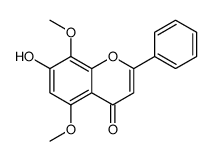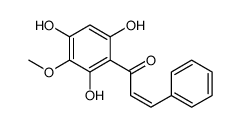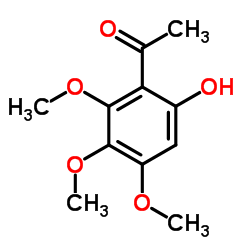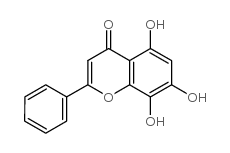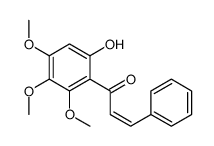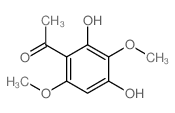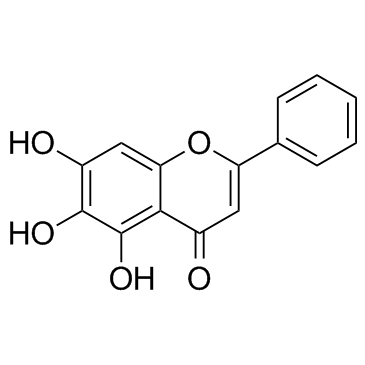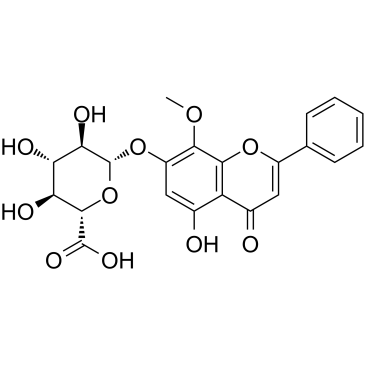632-85-9
| 中文名 | 汉黄芩素 |
|---|---|
| 英文名 | wogonin |
| 中文别名 |
5,7-二羟基-8-甲氧基-2-苯基-4H-1-苯并呋喃-4-酮
5,7-二羟基-8-甲氧基-2-苯基-4H-1-苯并呋喃-4-酮 汉黄芩黄酮 |
| 英文别名 |
Norwogonin 8-methyl ether
5,7-DIHYDROXY-8-METHOXYFLAVON 5,7-Dihydroxy-8-methoxy-2-phenyl-chromen-4-on Wogonin 5,7-Dihydroxy-8-methoxy-2-phenyl-4H-chromen-4-one 5,7-dihydroxy-8-methoxy-2-phenyl-chromen-4-one 4H-1-Benzopyran-4-one, 5,7-dihydroxy-8-methoxy-2-phenyl- MFCD00017736 5,7-dihydroxy-8-methoxyflavone vogonin WOOGONIN WILDYAMP.E |
| 描述 | Wogonin 是一种天然黄酮类物质,能够抑制 CDK8 and Wnt 的活性,具有抗炎、抗肿瘤等功效。 |
|---|---|
| 相关类别 | |
| 靶点 |
CDK8 Wnt |
| 体外研究 | 汉黄芩素(0-200μM)表现出caco-2,SW1116和HCT116细胞的细胞活力的剂量和时间依赖性降低。汉黄芩素(10-40μM)诱导HCT-116细胞G1期阻滞。汉黄芩素还抑制HCT116细胞中的Wnt信号传导途径。 Wogonin干扰转录因子TCF/Lef家族的活动。此外,汉黄芩素通过抑制CDK8的活性来抑制β-连环蛋白介导的转录[1]。汉黄芩素对HeLa细胞具有细胞毒性和抗增殖作用。汉黄芩素(90μM)在G0-G1期诱导细胞周期停滞,并在HeLa细胞中显着抑制细胞周期蛋白D1和Cdk4的水平[2]。汉黄芩素(1.25,2.5,5,10,20μg/ ml)抑制RAW264.7细胞中EtOH诱导的炎症反应[3]。 |
| 体内研究 | 汉黄芩素(30,60 mg/kg)可降低异种移植模型中HCT116细胞的肿瘤生长[1]。汉黄芩素(25,50,100 mg/kg)可预防小鼠肝脏损伤和ALD的病理特征。汉黄芩素激活ALD和EtOH诱导的RAW264.7细胞小鼠的PPAR-γ表达[3]。 |
| 细胞实验 | 将HCT116细胞种植在96孔板上(每孔1×10 5个细胞)。加入不同浓度的汉黄芩素并孵育24小时。随后,将20μLMTT溶液(5mg / mL)转移至每个孔中,并将板在37℃和5%CO 2下孵育4小时。吸去上清液并加入100μLDMSO以溶解甲crystals晶体。摇动混合物并使用通用酶标仪在570nm下测量。 |
| 动物实验 | 将C57BL / 6小鼠,雄性,6-8周龄,体重18-22g小鼠饲养在舒适的环境中并在实验前适应3天。将总共48只小鼠随机分成6组,每组8只动物,分别为对照饮食(CD)喂养的小鼠,喂食EtOH的小鼠,以25,50,100mg / kg /天的剂量处理的汉黄芩素小鼠和阳性(地塞米松,1mg / kg /天)治疗的小鼠。建模过程总共有16天,包括3天的液体饮食适应期和13天的模型。喂食EtOH喂养的小鼠含有5%v / v乙醇液体饮食,添加某些维生素和胆碱16天,并且最后用单次狂欢乙醇(5g / kg,体重,20%乙醇)强饲小鼠。天。同时,汉黄芩素治疗的小鼠和阳性治疗的小鼠不仅加上乙醇给药,而且还加上每天灌胃的药物,而CD喂养的小鼠用对照液体饲料喂养并用等热量麦芽糖强饲。 -dextrin在最后一天。所有饮食均每天新鲜烹制。在最后一次灌胃酒精后9小时,在麻醉下处死小鼠,收集肝脏组织和血液用于进一步分析。 |
| 参考文献 |
| 密度 | 1.4±0.1 g/cm3 |
|---|---|
| 沸点 | 518.8±50.0 °C at 760 mmHg |
| 熔点 | 203-206°C |
| 分子式 | C16H12O5 |
| 分子量 | 284.263 |
| 闪点 | 198.4±23.6 °C |
| 精确质量 | 284.068481 |
| PSA | 79.90000 |
| LogP | 2.14 |
| 外观性状 | 黄色晶体 |
| 蒸汽压 | 0.0±1.4 mmHg at 25°C |
| 折射率 | 1.669 |
| 储存条件 | 存放在密封容器内,并放在阴凉,干燥处,2-10ºC避光保存。储存的地方必须远离氧化剂。 |
| 稳定性 | 远离氧化物,光,热。 |
| 分子结构 | 1、 摩尔折射率:74.64 2、 摩尔体积(m3/mol):200.1 3、 等张比容(90.2K):564.8 4、 表面张力(dyne/cm):63.4 5、 极化率(10-24cm3):29.59 |
| 计算化学 | 1.疏水参数计算参考值(XlogP):3 2.氢键供体数量:2 3.氢键受体数量:5 4.可旋转化学键数量:2 5.互变异构体数量:12 6.拓扑分子极性表面积76 7.重原子数量:21 8.表面电荷:0 9.复杂度:426 10.同位素原子数量:0 11.确定原子立构中心数量:0 12.不确定原子立构中心数量:0 13.确定化学键立构中心数量:0 14.不确定化学键立构中心数量:0 15.共价键单元数量:1 |
| 更多 | 1. 性状:黄色结晶或者结晶性粉末。 2. 密度(g/mL,25/4℃):未确定 3. 相对蒸汽密度(g/mL,空气=1):未确定 4. 熔点(ºC):203-206 5. 沸点(ºC,常压):未确定 6. 沸点(ºC,5.2kPa):未确定 7. 折射率:未确定 8. 闪点(ºC):未确定 9. 比旋光度(º):未确定 10. 自燃点或引燃温度(ºC):未确定 11. 蒸气压(kPa,25ºC):未确定 12. 饱和蒸气压(kPa,60ºC):未确定 13. 燃烧热(KJ/mol):未确定 14. 临界温度(ºC):未确定 15. 临界压力(KPa):未确定 16. 油水(辛醇/水)分配系数的对数值:未确定 17. 爆炸上限(%,V/V):未确定 18. 爆炸下限(%,V/V):未确定 19. 溶解性:几乎不溶于水,微溶于醇类。 |
|
SECTION 1: Identification of the substance/mixture and of the company/undertaking Product identifiers Product name: Wogonin hydrate REACH No.: A registration number is not available for this substance as the substance or its uses are exempted from registration, the annual tonnage does not require a registration or the registration is envisaged for a later registration deadline.
CAS-No.: 632-85-9 Relevant identified uses of the substance or mixture and uses advised against Identified uses: Laboratory chemicals, Manufacture of substances SECTION 2: Hazards identification Classification of the substance or mixture Not a hazardous substance or mixture according to Regulation (EC) No. 1272/2008. This substance is not classified as dangerous according to Directive 67/548/EEC. Label elements The product does not need to be labelled in accordance with EC directives or respective national laws. Other hazards - none SECTION 3: Composition/information on ingredients Substances Synonyms: 5,7-Dihydroxy-8-methoxyflavone Formula: C16H12O5 · xH2O Molecular Weight: 284,26 g/mol CAS-No.: 632-85-9 No components need to be disclosed according to the applicable regulations. SECTION 4: First aid measures Description of first aid measures If inhaled If breathed in, move person into fresh air. If not breathing, give artificial respiration. In case of skin contact Wash off with soap and plenty of water. In case of eye contact Flush eyes with water as a precaution. If swallowed Never give anything by mouth to an unconscious person. Rinse mouth with water. Most important symptoms and effects, both acute and delayed The most important known symptoms and effects are described in the labelling (see section 2.2) and/or in section 11 Indication of any immediate medical attention and special treatment needed no data available SECTION 5: Firefighting measures Extinguishing media Suitable extinguishing media Use water spray, alcohol-resistant foam, dry chemical or carbon dioxide. Special hazards arising from the substance or mixture Carbon oxides Advice for firefighters Wear self contained breathing apparatus for fire fighting if necessary. Further information no data available SECTION 6: Accidental release measures Personal precautions, protective equipment and emergency procedures Avoid dust formation. Avoid breathing vapours, mist or gas. For personal protection see section 8. Environmental precautions Do not let product enter drains. Methods and materials for containment and cleaning up Sweep up and shovel. Keep in suitable, closed containers for disposal. Reference to other sections For disposal see section 13. SECTION 7: Handling and storage Precautions for safe handling Provide appropriate exhaust ventilation at places where dust is formed.Normal measures for preventive fire protection. For precautions see section 2.2. Conditions for safe storage, including any incompatibilities Store in cool place. Keep container tightly closed in a dry and well-ventilated place. Recommended storage temperature: 2 - 8 °C Specific end use(s) A part from the uses mentioned in section 1.2 no other specific uses are stipulated SECTION 8: Exposure controls/personal protection Control parameters Components with workplace control parameters Exposure controls Appropriate engineering controls General industrial hygiene practice. Personal protective equipment Eye/face protection Use equipment for eye protection tested and approved under appropriate government standards such as NIOSH (US) or EN 166(EU). Skin protection Handle with gloves. Gloves must be inspected prior to use. Use proper glove removal technique (without touching glove's outer surface) to avoid skin contact with this product. Dispose of contaminated gloves after use in accordance with applicable laws and good laboratory practices. Wash and dry hands. The selected protective gloves have to satisfy the specifications of EU Directive 89/686/EEC and the standard EN 374 derived from it. Body Protection Choose body protection in relation to its type, to the concentration and amount of dangerous substances, and to the specific work-place., The type of protective equipment must be selected according to the concentration and amount of the dangerous substance at the specific workplace. Respiratory protection Respiratory protection is not required. Where protection from nuisance levels of dusts are desired, use type N95 (US) or type P1 (EN 143) dust masks. Use respirators and components tested and approved under appropriate government standards such as NIOSH (US) or CEN (EU). Control of environmental exposure Do not let product enter drains. SECTION 9: Physical and chemical properties Information on basic physical and chemical properties a) AppearanceForm: solid b) Odourno data available c) Odour Thresholdno data available d) pHno data available e) Melting point/freezingno data available point f) Initial boiling point and no data available boiling range g) Flash pointno data available h) Evapouration rateno data available i) Flammability (solid, gas) no data available j) Upper/lowerno data available flammability or explosive limits k) Vapour pressureno data available l) Vapour densityno data available m) Relative densityno data available n) Water solubilityno data available o) Partition coefficient: n- no data available octanol/water p) Auto-ignitionno data available temperature q) Decompositionno data available temperature r) Viscosityno data available s) Explosive propertiesno data available t) Oxidizing propertiesno data available Other safety information no data available SECTION 10: Stability and reactivity Reactivity no data available Chemical stability Stable under recommended storage conditions. Possibility of hazardous reactions no data available Conditions to avoid no data available Incompatible materials Strong oxidizing agents Hazardous decomposition products Other decomposition products - no data available In the event of fire: see section 5 SECTION 11: Toxicological information Information on toxicological effects Acute toxicity no data available Skin corrosion/irritation no data available Serious eye damage/eye irritation no data available Respiratory or skin sensitisation no data available Germ cell mutagenicity no data available Carcinogenicity IARC:No component of this product present at levels greater than or equal to 0.1% is identified as probable, possible or confirmed human carcinogen by IARC. Reproductive toxicity no data available Specific target organ toxicity - single exposure no data available Specific target organ toxicity - repeated exposure no data available Aspiration hazard no data available Additional Information RTECS: LK8331000 To the best of our knowledge, the chemical, physical, and toxicological properties have not been thoroughly investigated. SECTION 12: Ecological information Toxicity no data available Persistence and degradability no data available Bioaccumulative potential no data available Mobility in soil no data available Results of PBT and vPvB assessment PBT/vPvB assessment not available as chemical safety assessment not required/not conducted Other adverse effects no data available SECTION 13: Disposal considerations Waste treatment methods Product Offer surplus and non-recyclable solutions to a licensed disposal company. Contaminated packaging Dispose of as unused product. SECTION 14: Transport information UN number ADR/RID: -IMDG: -IATA: - UN proper shipping name ADR/RID: Not dangerous goods IMDG: Not dangerous goods IATA:Not dangerous goods Transport hazard class(es) ADR/RID: -IMDG: -IATA: - Packaging group ADR/RID: -IMDG: -IATA: - Environmental hazards ADR/RID: noIMDG Marine pollutant: noIATA: no Special precautions for user no data available SECTION 15: Regulatory information This safety datasheet complies with the requirements of Regulation (EC) No. 1907/2006. Safety, health and environmental regulations/legislation specific for the substance or mixture no data available Chemical Safety Assessment For this product a chemical safety assessment was not carried out SECTION 16: Other information Further information Copyright 2013 Co. LLC. License granted to make unlimited paper copies for internal use only. The above information is believed to be correct but does not purport to be all inclusive and shall be used only as a guide. The information in this document is based on the present state of our knowledge and is applicable to the product with regard to appropriate safety precautions. It does not represent any guarantee of the properties of the product. Corporation and its Affiliates shall not be held liable for any damage resulting from handling or from contact with the above product. See and/or the reverse side of invoice or packing slip for additional terms and conditions of sale. |
|
生态学数据: 通常对水是不危害的,若无政府许可,勿将材料排入周围环境。 CHEMICAL IDENTIFICATION
HEALTH HAZARD DATAACUTE TOXICITY DATAMUTATION DATA
|
| 危害码 (欧洲) | Xn |
|---|---|
| 风险声明 (欧洲) | R20/21/22:Harmful by inhalation, in contact with skin and if swallowed . R36/37/38:Irritating to eyes, respiratory system and skin . |
| 安全声明 (欧洲) | S26-S36/37/39-S45 |
| 危险品运输编码 | 3145 |
| RTECS号 | SJ8922500 |
| 包装等级 | III |
| 危险类别 | 8 |



